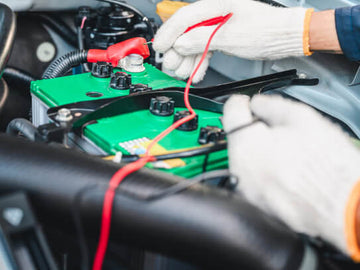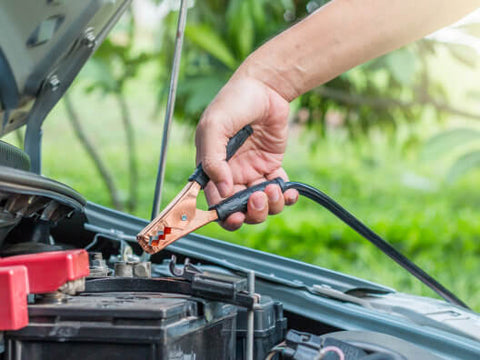
When considering the power of a jump starter, several key components come into play, each influencing its effectiveness in starting a vehicle.
Key Components of a Jump Starter
Components Affect a Jump Starter's Power?
Jump starter power is primarily determined by the quality and capacity of its internal battery. A larger battery with higher capacity can deliver more power to the vehicle's battery, making it more effective in jump-starting larger vehicles or batteries with higher cranking amp requirements. Additionally, the quality of internal components such as the cables, clamps, and internal circuitry can also impact the overall power output of the jump starter.
Voltage and Amperage Ratings Affecting the Performance of a Jump Starter
Voltage and amperage ratings are critical factors that directly influence the performance of a jump starter. Voltage refers to the electrical potential difference between two points and is typically measured in volts (V). Higher voltage ratings allow the jump starter to deliver more power to the vehicle's battery, facilitating faster and more efficient starting. Amperage, on the other hand, refers to the rate of flow of electric current and is measured in amperes (A). A higher amperage rating indicates that the jump starter can supply more current to the battery, which is essential for overcoming resistance and initiating the starting process. Together, voltage and amperage ratings determine the overall power output of the booster batterie, making them crucial considerations when selecting the right model for your needs.
By understanding these key components and their impact on jump starter power, you can make informed decisions when choosing the best jump starter for your vehicle. Whether you're dealing with a dead battery on the road or preparing for emergencies at home, having a reliable jump starter can provide peace of mind and ensure that you're always ready to get back on the road.
Portable Jump Starter Capacity
When it comes to portable battery boosters, understanding their capacity is crucial for ensuring their effectiveness in jump-starting vehicles.
The Imprtance of Capacity for Portable Jumper Starters
Capacity plays a significant role in determining how much power a portable jump starter can deliver to a vehicle's battery. Essentially, the capacity refers to the amount of electrical energy that the jump starter's battery can store. A higher capacity means that the jump starter can provide more energy to the battery, increasing the likelihood of successfully starting the vehicle, especially in cold weather or with larger engines that require more cranking power.
How Does Capacity Influence Car Battery Boosting?
The capacity of a portable jump starter directly impacts its ability to boost a car battery effectively. When a vehicle's battery is depleted, it requires a significant amount of electrical energy to jump-start the engine. A jump starter with higher capacity can deliver this energy more efficiently, providing the necessary power to overcome the resistance in the battery and initiate the starting process. Additionally, a portable jump starter with ample capacity may be able to jump-start multiple vehicles on a single charge, making it a versatile and reliable tool for emergencies.
By understanding the importance of capacity in portable jump starters and how it influences car battery boosting, you can make informed decisions when selecting the right jump starter for your needs. Whether you're a frequent traveler, a DIY enthusiast, or simply want to be prepared for unexpected roadside emergencies, choosing a portable jump starter with sufficient capacity ensures that you'll have the power you need to get back on the road quickly and safely.
Evaluating Car Battery Booster Output

Before investing in a car battery booster, it's essential to understand the key output features and how they can impact the starting process of your vehicle.
What Output Features Are Crucial in Car Battery Boosters?
Several output features play a crucial role in determining the effectiveness of a car battery booster. One of the most important features to consider is the peak current or cranking amps rating. This rating indicates the maximum amount of current that the booster can deliver to the vehicle's battery to initiate the starting process. A higher peak current rating typically means that the booster can provide more power, making it more effective for jump-starting larger vehicles or batteries with higher cranking amp requirements. Additionally, the voltage output of the booster is another critical factor to consider. Most vehicles operate on a 12-volt electrical system, so ensuring that the booster provides the correct voltage output is essential for compatibility and safety.
The output rating of a car battery booster directly affects its ability to start a vehicle. When a vehicle's battery is depleted, it requires a significant amount of electrical energy to overcome the resistance and initiate the starting process. A booster with a higher output rating, such as the Amproad portable jump starter with its 4000A peak current, can deliver this energy more effectively, providing the necessary power to jump-start the engine. Additionally, a booster with a higher output rating may be able to jump-start the vehicle more quickly, reducing the time spent stranded on the roadside. However, it's essential to ensure that the booster's output rating is compatible with your vehicle's battery and electrical system to avoid damage or safety hazards.
How Does Output Rating Affect Vehicle Starting?
The output rating of a car battery booster directly affects its ability to start a vehicle. When a vehicle's battery is depleted, it requires a significant amount of electrical energy to overcome the resistance and initiate the jump start process. A booster with a higher output rating can deliver this energy more effectively, providing the necessary power to jump-start the engine. Additionally, a booster with a higher output rating may be able to jump-start the vehicle more quickly, reducing the time spent stranded on the roadside. However, it's essential to ensure that the booster's output rating is compatible with your vehicle's battery and electrical system to avoid damage or safety hazards.
By evaluating the output features of car battery boosters and understanding how they affect vehicle starting, you can make an informed decision when selecting the right booster for your needs. Whether you're dealing with a dead battery in your own vehicle or assisting someone else in need, having a reliable car battery booster can provide peace of mind and ensure that you're always prepared for unexpected emergencies on the road.
Comparing Portable Battery Boosters
When it comes to selecting a portable battery booster, understanding the key differences between various models is essential to make an informed decision.
What Distinguishes Various Portable Battery Boosters?
Portable battery boosters come in a variety of models, each with its own unique features and capabilities. Some factors that distinguish one booster from another include the peak current rating, battery capacity, size, weight, and additional features such as built-in flashlights, USB ports for charging devices, and safety features like overcharge protection and reverse polarity protection. For example, while some boosters may prioritize compactness and lightweight design for easy portability, others may prioritize higher peak current ratings for jump-starting larger vehicles or batteries with higher cranking amp requirements.
How Do Different Specifications Affect Performance?
The specifications of a portable car jump box directly impact its performance and usability in jump-starting vehicles. The peak current rating, measured in amps, indicates the maximum amount of current that the booster can deliver to the vehicle's battery to initiate the starting process. A higher peak current rating typically means that the booster can provide more power, making it more effective for jump-starting larger vehicles or batteries with higher cranking amp requirements. Additionally, the battery capacity of the booster determines how many jump-starts it can perform on a single charge, as well as its ability to maintain charge over time. Other specifications, such as the size and weight of the booster, may also affect its usability and convenience, particularly for individuals who frequently travel or have limited storage space.
By comparing the various specifications of portable battery boosters and understanding how they affect performance, you can choose the best booster for your specific needs and requirements. Whether you're looking for a compact and lightweight booster for occasional use or a high-powered booster for heavy-duty applications, understanding the differences between models ensures that you'll have the right tool for jump-starting vehicles reliably and efficiently, wherever you go.
How to Boost a Car: Effective Jump Starting Tips

When faced with a dead car battery, knowing how to effectively use a car booster pack can save you time and hassle. Here are some essential tips for how to boost a car successfully.
What Are the Steps for Using a Jump Starter?
Prepare the vehicles: Park the booster vehicle close enough to the dead vehicle so that the jumper cables can reach both batteries comfortably. Ensure both vehicles are turned off before proceeding.
- Connect the jumper cables: First, connect the positive (+) terminal of the jumper cable to the positive terminal of the dead battery. Then, connect the other end of the positive cable to the positive terminal of the booster battery. Next, connect the negative (-) cable to the negative terminal of the booster battery. Finally, connect the other end of the negative cable to a metal surface on the engine block of the dead vehicle, away from the battery.
- Start the booster vehicle: Start the engine of the booster vehicle and let it run for a few minutes to allow the dead battery to charge.
- Start the dead vehicle: Attempt to start the engine of the dead vehicle. If it starts successfully, let both vehicles run for a few minutes to ensure the battery is sufficiently charged.
- Disconnect the cables: Once the dead vehicle is running smoothly, carefully disconnect the jumper cables in the reverse order in which they were connected, starting with the negative cable from the engine block and ending with the positive cable from the dead battery.
What Safety Measures Should Be Followed During Use?
- Wear protective gear: When handling jumper cables and batteries, wear gloves and safety glasses to protect yourself from potential electrical hazards and battery acid.
- Ensure proper cable connections: Double-check that the jumper cables are securely connected to the battery terminals and that there are no frayed wires or loose connections.
- Avoid sparks: Keep the ends of the jumper cables away from each other and any metal surfaces to prevent sparks, which could ignite flammable gases emitted by the batteries.
- Turn off electronics: Turn off all electronic devices and accessories in both vehicles before jump starting to avoid potential damage from power surges.
- Follow manufacturer instructions: Always refer to the manufacturer's instructions for both the jump starter and the vehicles involved for specific guidelines and safety precautions.
By following these tips and precautions, you can safely and effectively jump start a car using a jump starter, ensuring that you're always prepared for unexpected battery failures on the road.


